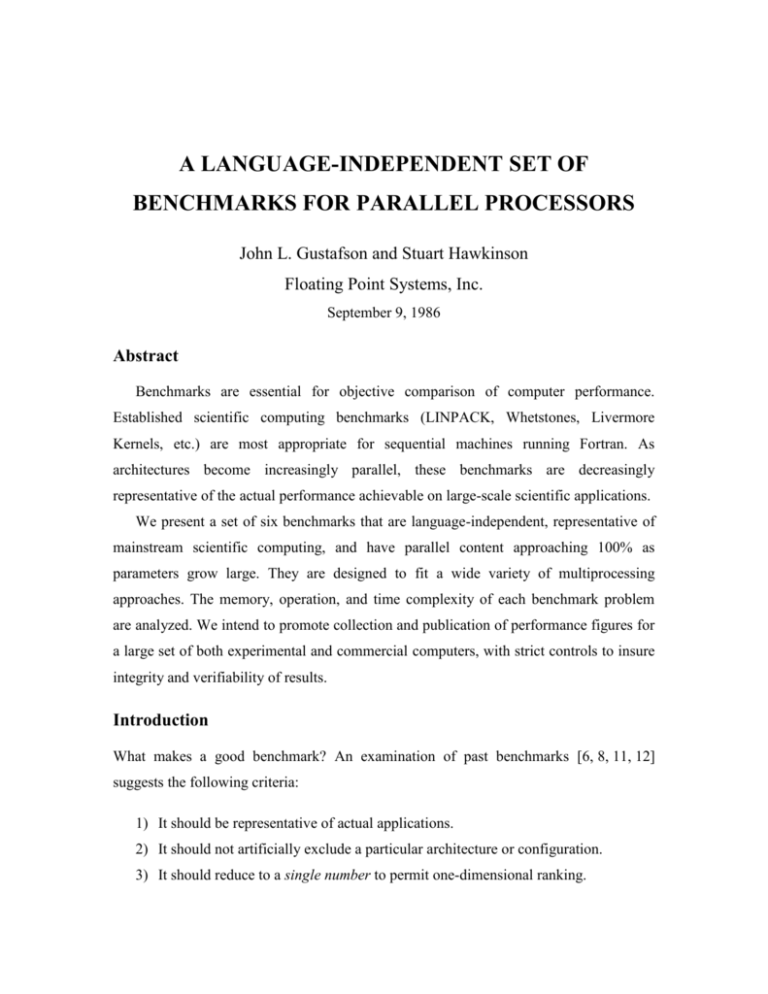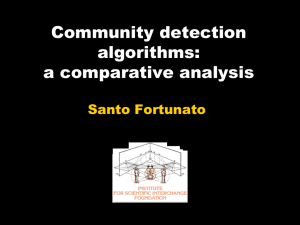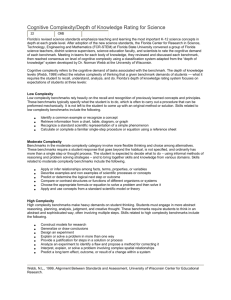a language-independent set of benchmarks for parallel processors
advertisement

A LANGUAGE-INDEPENDENT SET OF BENCHMARKS FOR PARALLEL PROCESSORS John L. Gustafson and Stuart Hawkinson Floating Point Systems, Inc. September 9, 1986 Abstract Benchmarks are essential for objective comparison of computer performance. Established scientific computing benchmarks (LINPACK, Whetstones, Livermore Kernels, etc.) are most appropriate for sequential machines running Fortran. As architectures become increasingly parallel, these benchmarks are decreasingly representative of the actual performance achievable on large-scale scientific applications. We present a set of six benchmarks that are language-independent, representative of mainstream scientific computing, and have parallel content approaching 100% as parameters grow large. They are designed to fit a wide variety of multiprocessing approaches. The memory, operation, and time complexity of each benchmark problem are analyzed. We intend to promote collection and publication of performance figures for a large set of both experimental and commercial computers, with strict controls to insure integrity and verifiability of results. Introduction What makes a good benchmark? An examination of past benchmarks [6, 8, 11, 12] suggests the following criteria: 1) It should be representative of actual applications. 2) It should not artificially exclude a particular architecture or configuration. 3) It should reduce to a single number to permit one-dimensional ranking. 4) It should be large enough to exercise features of large machines, and be scalable to smaller and larger versions. 5) It should report enough details to be reproducible by an independent investigator. 6) It should permit simple verification of the correctness of results. 7) It should use algorithms simple enough to describe in about one page of text. The ultimate goal of any benchmark is to estimate performance on an actual application of interest. Hence, the benchmark should be designed so that its onedimensional ranking correlates well with a ranking of performance on the application. While this sounds like a nearly impossible task, benchmarks of scalar scientific computers have in fact historically been accepted as measures of application performance. The requirement that a benchmark run on a variety of architectures and configurations has been neglected in many previous studies. The Whetstone benchmark [2], for example, is specifically designed to defeat attempts to vectorize, parallelize, or pipeline the code. Its operations are recursive, and hence measure only scalar performance. More recently, D. H. Bailey and J. T. Barton [1] have attempted to rectify this situation. Their NAS benchmarks provide seven Fortran kernels for vector uniprocessors and are intended to measure current supercomputer performance. The philosophy, however, is still one of minimum alteration to a specific Fortran formulation. Of the many parallel research machines recently funded by DARPA, not one is capable of illustrating its performance on the NAS benchmarks as stated. There obviously needs to be more flexibility in implementation if a performance metric is to have staying power. The requirement that the benchmark reduce to a single number is based on the historical misuse of benchmarks. The Livermore Kernels [9] present an entire statistical base of data, with 24 kernels run using three different mean vector lengths. Yet, performance on those kernels is often stated as a single number, which might be the harmonic mean or the arithmetic mean of various subsets of the data. It is clear that computer performance is a multi-dimensional quantity, but in practice, the metric inevitably becomes one-dimensional with repeated use. Even the Whetstone benchmark was originally intended as a weighted mean of several operations, with different sets of weights for different application mixes; yet the only numbers ever used are the default weights suggested by Curnow and Wichmann [2]. It is better for a benchmark problem to be too large than too small. Ten years ago, solving 100 equations in 100 unknowns with 14-decimal accuracy seemed like a challenging computer task. On today’s supercomputers, such a problem uses less than 1% of a machine’s main memory. The problem has vectors too short to effectively amortize the cost of vector startup in the arithmetic pipelines. Since applications have grown with the available hardware, such a small problem is no longer representative of large-scale scientific computation. Fortunately, the problem is easily scaled, and solution times for 300-equation and 1000-equation systems are beginning to be quoted [3]. Dense systems as large as 25000 by 25000 have been recently run as performance tests at Floating Point Systems. Benchmarks are experiments, subject to the same control requirements as any other scientific experiment. A measurement of a computing system must be accompanied by considerable supporting information, such as: 1) Numerical format used (mantissa size, exponent size) 2) Operating system release level 3) Language and release level; directives and options used 4) Memory size, cache, mass storage, and any other variable storage information 5) Number of processors, interprocessor communication speeds, processor clock speeds, and any other physical variables of the configuration 6) Date run 7) Who performed the measurement, and how that person can be contacted These requirements are a bare minimum for reproducibility in the experiment. It is assumed that no other users are present on a computer system running a benchmark problem, and that times quoted are always elapsed times rather than “CPU time” or other subset of the computing resource. Perhaps the most important item in the above list is the name of the person who performed the benchmark. Too often, published benchmarks use anonymous sources, which reduces the traceability of the results. Ideally, results should be gathered and maintained by an independent national agency; the National Bureau of Standards has already expressed interest in taking on this responsibility [10] The ease-of-verification requirement is obvious. If one does not require that programs run correctly, then one can make them run very quickly indeed. We take the view that the person who programs the benchmark for a particular machine is responsible for making certain that the program actually does the stated job. While verification facilities can be provided in the program, a person motivated to circumvent them will probably never have the least bit of trouble doing so. Proof of correctness should be viewed similarly to the requirement for correctness in published mathematical proofs; testing a theorem by example might weed out an error, but can never prove correctness. Finally, the algorithms describing the benchmark problems should be describable in about one page of text. Benchmarks are often criticized as being too short to represent very large application programs, and this is particularly valid if one is measuring a machine with a program cache. The tradeoff is that long benchmarks are generally much harder to convert to various machines, greatly reducing the eventual database of the benchmark. John Swanson has collected a sizeable list of computer performance on his ANSYS® structural analysis code (over 150,000 lines of Fortran), but only within the realm of sequential Fortran processors. Swanson’s measurements are among the best, however, for revealing overall system performance on a large Fortran program. In general, however, a small set of short kernels can be representative of overall performance in scientific applications; we make the tradeoff in the direction of simplicity because of the desire for language independence. An excellent example of a language-independent benchmark in wide use is the Fast Fourier Transform. It is usually cited for either a 1024-point linear array, or the twodimensional transform of a 1024 by 1024-point array of complex numbers. Although it is generally not specified whether the data is left bit-reversed or in correct order, the FFT benchmark needs no statement about specific data, language, number of processors, etc. The correctness of the program is easily checked by applying the inverse FFT and comparing with the original data. It conveys speed on a problem of intense interest to certain applications. This is the paradigm for our six benchmark problems. We have selected six problems that represent a cross-section of scientific computing: 1) Matrix Multiplication 2) Wave Equation 3) Linear System Solution 4) Two-Dimensional Convolution 5) Two-Dimensional Discrete Fourier Transform 6) Three-Dimensional N-Body Simulation As typified by the FFT, each benchmark is described as a mathematical task to be performed, with plenty of freedom to allow a programmer to use a particular machine to good advantage. For clarity, we supply a sample implementation in Fortran. The problem is analyzed for memory complexity, operation complexity, time complexity, theoretical maximum parallelism in the flow of data, what architectural features are being exercised, and what applications correlate well with the problem. Each Fortran listing is intended only as an explanation of the problem being solved, not as a specification of the order of computations. The authors have little interest in knowing how cleverly an optimizing Fortran compiler can reconstruct parallelism from the serialized versions shown here. Data are generated with a system-supplied function “RAN(ISEED)” which delivers a pseudo-random sequence of real values uniformly distributed between 0 and 1. It may be assumed that the data do not produce underflow, overflow, or division by zero. The Fortran examples use a system call “SECONDS(T1)” which returns the absolute “wall clock” time in T1; this can then be used to compute elapsed time. Storage required, or “memory complexity,” is stated as an asymptotic term which ignores lower-order terms and scratch usage. It also does not account for the possible need for redundant storage on multiple processors. “Operation complexity” refers to the total number of floating-point operations required by the algorithm. “Time complexity” refers to the number of operations in the critical path of the data dependency graph. Execution time on a serial computer will depend mostly on operation complexity; execution time on a highly parallel computer will depend mostly on time complexity. With the exception of the industry-standard 1K by 1K FFT, the parameters have been chosen so that the benchmarks have operation complexities of approximately one billion. We use the operation weighting suggested by McMahon [9]: Operation Complexity Add, subtract, compare 1 Multiply 1 Reciprocal 3 Square root 4 “Maximum parallelism” describes the breadth of the data dependency graph, that is, the maximum concurrency that can be exploited in the algorithm. The algorithms all have maximum parallelism in excess of 106 using the suggested parameters, so that even massively parallel designs will be able to demonstrate performance improvements. BENCHMARKS Implementation Notes: All floating-point numbers are assumed to have a dynamic range of at least 10–300 to 10+300 and at least 15 decimal digits of mantissa precision. All computers with hardware or software based on the IEEE proposed 64-bit floating-point standard meet this requirement. A complex number consists of two such floating-point numbers and thus requires at least 128 bits. A “word” is a unit of storage with at least 64 bits. Timing begins when the first calculation is performed on input data (not parameters). It ends when the last necessary calculation is finished. The data can be stored wherever convenient before starting the timer (registers, caches, multiple local memories, etc.) Timing should not include the time required to fill the arrays with starting data, even if data is stored redundantly on multiple processors. The data may be stored in any regular order required for maximum performance. Precomputing results or partial results is not permitted unless specifically stated in the problem description. The “single number” quoted for this suite of six benchmarks is the sum of the six individual timings. Equivalently, one may compute total MFLOPS as the total number of floating-point operations (operation complexity) divided by the total number of microseconds of elapsed time, if care is taken to consider only those MFLOPS essential to the computation. (A driver program is being developed to implement these guidelines and execute the six benchmarks. It will produce a table of required information and a summary of results.) 1) MATRIX MULTIPLICATION Given N-by-N 64-bit floating-point matrices A and B, compute the matrix product C = AB. All matrices are considered dense and asymmetric. Sample parameter: N = 1024. Fortran sample implementation: C C Problem 1: Matrix Multiplication JLG 3/14/86 PARAMETER (N=1024) REAL A(N,N), B(N,N), C(N,N) C C C Set up matrix data. 1 C C C Start timer and begin computation. 3 2 C C C ISEED = 31415 DO 1 I = 1, N DO 1 J = 1, N A(I,J) = RAN(ISEED) B(I,J) = RAN(ISEED) CALL SECONDS(T1) DO 2 I = 1, N DO 2 J = 1, N SUM = A(I,1) * B(1,J) DO 3 K = 2, N SUM = SUM + A(I,K) * B(K,J) C(I,J) = SUM Finished; stop timer. CALL SECONDS(T2) WRITE(6,*) ' Elapsed time in seconds:', T2 - T1 STOP END Memory complexity: Approximately 2N 2 words (by replacing A or B with the result C). (For N = 1024, this is 2.1 million words, or 17 million bytes). Operation complexity: N 3 multiplications, N 3 – N 2 additions; 2N 3 – N 2 total floatingpoint operations. (For N = 1024, this is 2.1464 billion floating-point operations.) Time complexity: 1 multiplication and lg N additions (see Figure 1.) (For N = 1024, this is 11 operations.) Maximum parallelism: N 3 multiplications. (For N = 1024, this is 1.1 billion.) Matrix multiplication should execute at very close to “peak theoretical speed” on most scientific computers. The ratio of floating-point multiplications to additions is nearly unity, which corresponds to a common design ratio of one adder functional unit to every multiplier functional unit. This benchmark tests ability to use arithmetic units with a minimum of communication overhead; each word of input data is used in N operations. Systolic algorithms using a two-dimensional mesh of processors are well known [7]; the diagram below suggests that logarithmic interconnectivity can further reduce execution time. Matrix multiplication is essential for similarity transformations and certain kinds of eigenvalue-eigenvector computation. Computational chemistry depends heavily on matrix multiplication for ab initio modeling of molecular behavior. Figure 1. Parallel Matrix Multiplication 2) WAVE EQUATION Simulate the wave equation on the interior of an N-by-N grid of points. Follow the progress of the wave through T time steps. Two time steps, U(i, j) and V(i, j), are initialized before timing starts. The boundaries of the grids are initialized to zero, and are never updated. The interiors are initialized to dense sets of floating-point numbers. The simulation uses an explicit time stepping scheme: U(i, j ) [V(i + 1, j) + V(i – 1, j) + V(i, j + 1) + V(i, j – 1)] 0.5 – U(i, j) for 2 ≤ i, j ≤ N – 1, followed by V(i, j ) [U(i + 1, j) + U(i – 1, j) + U(i, j + 1) + U(i, j – 1)] 0.5 – V(i, j) for 2 ≤ i , j ≤ N – 1. Each update of U and then V counts as two time steps. Only the last two time steps are to be saved. Sample parameters: N=1024, T=250. Fortran sample implementation: C C Problem 2: Wave Equation JLG 3/14/86 PARAMETER (N = 1024, N2 = N/2, ITIME = 250) REAL U(N,N), V(N,N) C C C Initialize the time steps. 1 C C C Start the timer and begin computing. 3 4 2 C C C ISEED = 31415 DO 1 I = 1, N DO 1 J = 1, N U(I,J) = RAN(ISEED) V(I,J) = RAN(ISEED) U(N2,N2) = 100.0 CALL SECONDS(T1) DO 2 NT = 1, ITIME - 1, 2 DO 3 I = 2, N-1 DO 3 J = 2, N-1 U(I,J) = (V(I+1,J)+V(I-1,J) $ + V(I,J+1)+V(I,J-1))*0.5 - U(I,J) CONTINUE DO 4 I = 2, N-1 DO 4 J = 2, N-1 V(I,J) = (U(I+1,J)+U(I-1,J) $ + U(I,J+1)+U(I,J-1))*0.5 - V(I,J) CONTINUE CONTINUE Finished; stop timer. CALL SECONDS(T2) WRITE(6,*) ' Elapsed time in seconds:', T2 - T1 STOP END Memory complexity: Approximately 2N 2 words. (For N = 1024, this is 2.1 million words, or 17 million bytes.) Operation complexity: 4(N – 2)2T additions, (N – 2)2T multiplications; 5(N – 2)2T total floating-point operations. [By re-using sums, the additions can be reduced to 3(N – 2)2T at the expense of reducing the maximum parallelism somewhat. In this case, use 4(N – 2)3T to compute MFLOPS ratings from this benchmark. (For N = 1024 and T = 250, this is 1.0445 billion floating-point operations.)] Time complexity: 3T additions and T multiplications. (See Figure 2). (For T = 250, this is 1000 operations.) Maximum parallelism: 2N2 additions at the beginning of every time step. (For N = 1024, this is 2.1 million.) This benchmark is memory/communication intensive, since each word of data communicated between neighboring points only participates in a single calculation. However, the method is highly parallel because of the explicit formulation, which can exercise a large number of processors running similar programs. The wave equation is one of the most important equations of mathematical physics. It is used by the seismic industry to simulate various exploration strategies, sometimes using formulations scarcely more complicated than the one used here. Fluids can be modeled by similar methods when their behavior is wavelike (hyperbolic), such as in transonic flow. Figure 2. Parallel Wave Equation Simulation 3) LINEAR SYSTEM SOLUTION Given an N-by-N floating-point matrix A and an N-long floating-point vector b, find an N-long floating-point vector x such that Ax = b. All matrices and vectors are assumed dense. The matrix A is real, asymmetric, and nonsingular. Use any method with numerical error equal to or less than that of Gaussian elimination with partial pivoting. For example, one might use LU factorization with pivoting, then forward reduction, and then backsolving, or one might combine passes by using Gauss-Jordan elimination with pivoting. Pivoting must be across all non-eliminated columns, not just those local to a processor. A and b may be altered in the process of solution; only x is required as output. Sample parameters: N = 1023. (This allows the augmented matrix to have a width of 1024 elements.) Fortran sample implementation: C C Problem 3: Linear System Solution JLG 1/27/86 PARAMETER (N = 1023) REAL A(N,N+1), X(N), R(N) EQUIVALENCE (A(1,N+1), X(1)) C C C Set up matrix and vector data. ISEED = 31415 DO 1 I = 1, N DO 1 J = 1, N + 1 A(I,J) = RAN(ISEED) 1 C C C Start timer and begin computation. CALL SECONDS(T1) DO 2 K = 1, N - 1 S = ABS(A(K,K)) L = K DO 3 I = K + 1, N IF (S .GE. ABS(A(I,M))) GO TO 3 S = ABS(A(I,M)) L = I CONTINUE DO 4 I = K, N S = A(K,I) A(K,I) = A(L,I) A(L,I) = S R(K) = 1.0 / A(K,K) DO 5 I = K + 1, N S = A(I,K) * R(K) DO 5 J = K+1, N+1 A(I,J) = A(I,J) - S * A(K,J) CONTINUE R(N) = 1.0 / R(N) 3 4 5 2 C C C Backsolve... X(N) = X(N) * R(N) DO 6 I = N - 1, 1, -1 DO 7 J = I + 1, N X(I) = X(I) - X(J) * A(I,J) X(I) = X(I) * R(I) 7 6 C C C Finished; stop timer. CALL SECONDS(T2) WRITE(6,*) ' Elapsed time in seconds:', T2 - T1 STOP END Memory complexity: N2 words. (For N = 1023, this is 1 million words, or 8.4 million bytes.) Operation complexity: 1⁄3N 3 + N 2 – 1⁄3N additions (including comparison operations), 1⁄3N 3 + N 2 – 1⁄3N multiplications, and N reciprocals; 2⁄3 N 3 + 2N 2 + 7⁄3 N total floating- point operations. (For N = 1023, this is 0.7158 billion floating-point operations.) Time complexity: (lg N)(N+1) + 2N – 1 additions, 3N – 1 multiplications, and N reciprocals. (For N = 1023, time complexity is about 20000.) Maximum parallelism: (N – 1)2 multiplications and additions after the first pivot element is found. (For N = 1023, this is about 1 million.) Linear equations solving has a kernel that resembles matrix multiplication; however, the need to choose a pivot value introduces a major change for parallel computation. There is much more time complexity in Gaussian Elimination than in matrix multiplication, although each word of data participates in roughly the same number of calculations. The backsolving step tends to be communication-bound. Direct solvers are essential in several applications. Structural analysis uses direct solution on matrices with envelope sparsity; within the envelope, the operation resembles the problem described above. Integral formulations of boundary value problems (such as those used for determining radar cross-section) require direct solution of dense systems. In general, implicit formulations of physical problems result in a need to solve systems of simultaneous equations. Figure 3. Parallel Gaussian Elimination 4) TWO-DIMENSIONAL CONVOLUTION Given an image A and an M-by-M filter F, compute an N-by-N array B, the convolution of A with F. Compute only that subset such that the filter does not extend beyond the edge of the image; hence A must have dimensions N + M – 1 by N + M – 1. The convolution is defined as M M Bi M , j M Ai m, j n F m, n m1 n1 for i, j = M + 1 to N + M. Only B needs to be saved. Sample parameters: N = 1024, M = 25. Fortran sample implementation: C C Problem 4: Two-Dimensional Convolution JLG 3/14/86 PARAMETER (N = 1024, M = 25) DIMENSION A(N+M-1,N+M-1), B(N,N), F(M,M) C C C Set up image and filter data. 1 2 C C C Start timer and begin computation. 4 3 C C C ISEED = 31415 DO 1 I = 1, N+M-1 DO 1 J = 1, N+M-1 A(I,J) = RAN(ISEED) DO 2 I = 1, M DO 2 J = 1, M F(I,J) = RAN(ISEED) CALL SECONDS(T1) DO 3 I = M + 1, N + M DO 3 J = M + 1, N + M SUM = 0.0 DO 4 K = 1, M DO 4 L = 1, M SUM = SUM + A(I-K,J-L) * F(K,L) B(I-M,J-M) = SUM Finished; stop timer. CALL SECONDS(T2) WRITE(6,*) ' Elapsed time in seconds:', T2 - T1 END Memory complexity: Approximately 2N 2 words. (For N = 1024, this is 2.1 million words, or 16.8 million bytes.) Operation complexity: N 2(M 2 – 1) additions and N 2M 2 multiplications; N 2(2M 2 – 1) total floating-point operations. (For N = 1024 and M = 25, this is 1.3097 billion operations.) Time complexity: 2 lg M additions and 1 multiplication. (See Figure 4.) (For M = 25, this is 11 operations) Maximum parallelism: N 2M 2 multiplications in the first step. (For N = 1024 and M = 25, this is 655 million.) This function differs from matrix multiplication in its pattern of re-use of data. The filter data is re-used intensively and can be broadcast for effective parallelization. Convolution is the most important time-domain operation in signal and image processing. When filters become larger than about 64 elements in any dimension, FFT methods are more efficient. Convolution strongly resembles the fundamental operation of finite-difference iterative methods, applying an inner-product operator to a local subset of the data to “relax” toward a solution. Hence, performance on this benchmark should correlate strongly with performance on certain partial differential equation methods. Figure 4. Parallel Two-Dimensional Convolution 5) TWO-DIMENSIONAL DISCRETE FOURIER TRANSFORM Given an N-by-N image A consisting of complex pairs of floating-point numbers, compute its two-dimensional Discrete Fourier Transform B, followed by its scaled inverse C, which should reproduce the original image A. The transform is defined as Bk,l N 1N 1 Am, n km nl m0 n1 for k, l = 0, … , N – 1; its inverse is defined as C k,l N 1N 1 1 N 2 Bm, n km nl m0 n1 for m, n = 0, …, N – 1, where = e –2πi ⁄ N. FFT methodsmay be used, either in-place or out-of-place. Only C must be saved; timing ends when it is stored in the original order used to store A. Do not include time to prepare sine and cosine tables. Sample Parameter: N = 1024 Fortran sample implementation (see [1]): C C C Problem 5: Two-Dimensional Discrete Fourier Transform (using radix 2 FFT methods) JLG 1/26/86 PARAMETER (N = 1024, N2 = N/2) COMPLEX A(N,N), W(N) INTEGER IP(2,N) C C C Initialize trig tables and input data. 1 2 C C C ISEED = 31415 DO 1 I = 1, N2 T = 2. * 3.141592653589793 * (I-1) / N W(I) = CMPLX(COS(T), SIN(T)) DO 2 I = 1, N DO 2 J = 1, N A(I,J) = RAN(ISEED) SCALE = 1. / FLOAT(N * N) Start timer and begin computation. CALL CALL CALL CALL DO 3 DO 3 C C C SECONDS(T1) FFT(A,N,W,IP,+1) TRANS(A,N) FFT(A,N,W,IP,+1) I = 1, N 3 J = 1, N A(I,J) = A(I,J) * SCALE CALL FFT(A,N,W,IP,-1) CALL TRANS(A,N) CALL FFT(A,N,W,IP,-1) Finished; stop timer. CALL SECONDS(T2) WRITE(6,*) ' Elapsed time in seconds:', T2 - T1 STOP END C C C Compute 1D FFTs (based on routine by D.H. Bailey): 4 5 6 8 7 C C C SUBROUTINE FFT(A,N,W,IP,IFLAG) COMPLEX A(N,N), W(N), CX, CT INTEGER IP(2,N) DO 4 I = 1, N IP(1,I) = I L = 1 K1 = 1 K2 = 3 - K1 N2 = N/2 DO 6 J = L, N2, L CX = W(J-L+1) IF (IFLAG .LT. 0) CX = CONJG(CX) DO 6 I = J-L+1, J II = IP(K1,I) IP(K2,I+J-L) = II IM = IP(K1,I+N2) IP(K2,I+J) = IM DO 6 K = 1, N CT = A(II,K) - A(IM,K) A(II,K) = A(II,K) + A(IM,K) A(IM,K) = CT * CX L = 2 * L K1 = K2 IF (L .LE. N2) GO TO 5 DO 7 I = 1, N II = IP(K1,I) IF (II .LE. I) GO TO 7 DO 8 K = 1, N CT = A(I,K) A(I,K) = A(II,K) A(II,K) = CT CONTINUE RETURN END Transpose complex array in place. 9 SUBROUTINE TRANS(A,N) COMPLEX A(N,N), CT DO 9 I = 1, N - 1 DO 9 J = I + 1, N CT = A(I,J) A(I,J) = A(J,I) A(J,I) = CT RETURN END Memory complexity: Approximately 2N 2. (For N = 1024, this is about 2.1 million words, or 16.8 million bytes.) Operation complexity: If radix 2 FFT methods are used, there are 12 N 2 lg N additions and N 2(8 lg N + 2) multiplications; N 2(20 lg N + 2) total floating-point operations. This is not the theoretical minimum number of operations; however, use N 2(20 lg N + 2) to compute MFLOPS ratings for this benchmark. (For N = 1024, this is 0.2118 billion floating-point operations). Time complexity: 4 lg N + 1 multiplications and 8 lg N additions, for the radix 2 FFT. (For N = 1024, this is 121 operations). Maximum parallelism: 8N 2 multiplications in the beginning of each radix 2 FFT. (For N=1024, this is 8.4 million.) A number of multiprocessor connection schemes are appropriate for the FFT: hypercube, omega network, and butterfly, for example. Nearest-neighbor schemes in two or three dimensions do not have adequate direct interconnects for most factorings of the Discrete Fourier Transform. Besides the obvious importance of discrete Fourier Transforms in signal and image processing performing convolutions or extracting frequency spectra, they are essential for spectral methods used in mathematical physics. Computational fluid dynamics, notably weather modeling, sometimes uses FFTs to convert space-domain problems into more easily solved frequency-domain problems. Figure 5. Parallel Two-Dimensional FFT 6) THREE-DIMENSIONAL N-BODY SIMULATION Simulate the time evolution of a system of N point masses with Newtonian gravitational forces in three spatial dimensions; that is, the force between any two bodies mi and mj is described by Fij = –Gmimj rij ⁄ || rij ||3 where G is the gravitational constant and rij is the vector from mass i to mass j. For simplicity, we assume that G = 1 and mi = 1 for i = 1, … , N. Hence the total force on body mi is N Fi i j rij rij 3 Assume an initial set of nonzero velocities vi. Use a simple time stepping method [4] to update velocities and positions, with T time steps of size h. Compute Fi for i = 1, … , N. Then new velocities vi and ri are obtained from vi and ri using vi = vi + h Fi ri = ri + h vi for i = 1, … , N. Repeat for T time steps. Note that cluster approximations, which replace groups of particles with a point mass, are not permitted. Sample parameters: N = 1024, T = 50, h = 0.0001 Fortran sample implementation: C C Problem 6: N-Body Simulation JLG 3/14/86 PARAMETER (N = 1024, ITIME = 50, H = 0.0001) DIMENSION R(N,3),R1(N,3),V(N,3),V1(N,3),FORCE(3),DEL(3) C C C Set up initial positions and velocities. 1 C C C ISEED = 31415 DO 1 I = 1, N DO 1 J = 1, 3 R(I,J) = RAN(ISEED) V(I,J) = RAN(ISEED) Start timer and begin computation. 4 6 5 CALL SECONDS(T1) DO 2 NT = 1, ITIME DO 3 I = 1, N DO 4 IDIM = 1, 3 FORCE(IDIM) = 0.0 DO 5 J = 1, N IF (I .EQ. J) GO TO 5 DO 6 IDIM = 1,3 DEL(IDIM) = R(I,IDIM) - R(J,IDIM) RIJ = DEL(1)**2 + DEL(2)**2 + DEL(3)**2 RIJ = 1. / (RIJ * SQRT(RIJ)) DO 5 IDIM = 1, 3 FORCE(IDIM)=FORCE(IDIM)+DEL(IDIM)* RIJ CONTINUE DO 7 IDIM = 1, 3 V1(I,IDIM) = V(I,IDIM) + FORCE(IDIM) * H 7 3 8 2 C C C R1(I,IDIM) = R(I,IDIM) + V1(I,IDIM) * H CONTINUE DO 8 I = 1, N DO 8 IDIM = 1, 3 V(I,IDIM) = V1(I,IDIM) R(I,IDIM) = R1(I,IDIM) CONTINUE Finished; stop timer. CALL SECONDS(T2) WRITE(6,*) ' Elapsed time in seconds:', T2 - T1 END Memory complexity: 12N words. (For N = 1024, this is 12 Kwords, or 100 Kbytes). Operation complexity: (8N 2 – 2N)T additions, (7N 2 – N)T multiplications, (N 2 – N)T square roots, and (N 2 – N)T reciprocal operations; (22N 2 – 10N)T total floating-point operations. (For N = 1024 and T = 50, this is 1.1538 billion operations.) Time complexity: 6T additions, 5T multiplications, T square roots, and T reciprocals. (For T = 50, this is 90 operations.) Maximum Parallelism: 3(N 2 – N) additions at the beginning of each time step. (For N = 1024, this is 3.1 million.) A discussion of this problem and its fit to parallel architectures can be found in [5]. In general, ring interconnectivity is sufficient to achieve high parallel performance, despite the apparently high everything-to-everything costs. Plasma simulation and astrophysical simulations illustrate the range of applicability of such algorithms. Figure 6. Parallel N -Body Simulation SUMMARY The suite of six benchmarks presented in this paper is designed to measure the performance of parallel scientific computers. They are sufficiently general to permit various architectures to achieve a high percentage of their optimum performance. No artificial restrictions have been placed on language, evaluation order, or parallelism. The Fortran listings are meant only to clarify the computations required and serve as an independent source of results for testing. The size of each benchmark has been adjusted so that each kernel makes a significant contribution to the total execution time. The following table summarizes the six benchmarks for the sample parameters: Benchmark Memory, Megabytes Billions of Operations Minimum Time Max. Parallelism, Millions Matrix Multiplication 17. 2.1464 11 Wave Equation 17. 1.0445 1000 2.1 0.7158 20000 1. 655. Linear Equations 8.4 1074. Convolution 17. 1.3097 11 2D Fourier Transform 17. 0.2118 121 8.4 1.1538 90 3.1 N-Body Simulation 0.1 The guidelines presented should allow the reported benchmark results to be analyzed, understood, and repeated. It is hoped that these kernel computations will be run on many new parallel architectures regardless of language, task granularity, or memory organization. The authors would appreciate reports of any results and will promote their discussion to as wide an audience as possible. REFERENCES [1] Bailey, D. H., and Barton, J. T., “The NAS Kernel Benchmark Program,” NASA Technical Memorandum 86711, (August 1985). [2] Curnow, H. J., and Wichmann, B. A., “A Synthetic Benchmark,” Computer Journal, 19, 1, (February 1976). [3] Dongarra, J. J., “Performance of Various Computers Using Standard Linear Equations Software in a Fortran Environment,” ANL Technical Memorandum 23, (November 1985). [4] Feynman, R.P., The Feynman Lectures on Physics, Vol. I, Addison Wesley, (1964), 9–5 to 9–9. [5] Fox, G. C., and Otto, S. W., “Algorithms for Concurrent Processors,” Physics Today, (May 1984), 50–59. [6] Gustafson, J. L., “Measuring MFLOPS,” Floating Point Systems Application Note #52, (June 1985). [7] Kung, H.T., “Why Systolic Architectures,” IEEE Computer, 15, 1, (January 1982), 37–46. [8] Marvit, P., and Nair, M, “Benchmark Confessions,” BYTE, 9, 2, (February 1984), 227–230. [9] McMahon, F. H., “L.L.N.L FORTRAN KERNELS: MFLOPS,” Lawrence Livermore National Laboratory, (benchmark tape available), (1983). [10] National Bureau of Standards Announcement, “NBS Parallel Computer Benchmark Collection,” J. Comp. Physics, 61, (1985), 523. [11] Purdom, J., “Benchmark Philosophy and Methodology,” Computer Language, 3, 2, (February, 1986), 49–56. [12] Worlton, J., “Understanding Supercomputer Benchmarks,” Datamation, (September 1, 1984), 121–130.








